Navigation
Harvard Scientists Find Changing Atmosphere Affects How Much Water Trees Need
Increasing levels of atmospheric carbon dioxide alter how plants use water: Spurred by increasing levels of atmospheric carbon dioxide, forests over the last two decades have become dramatically more efficient in how they use water. "Findings from this study are important to our understanding of forest ecosystems--and how they can be managed more effectively now and in the future."
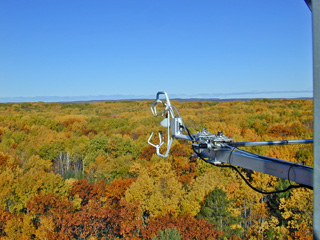 A sonic aerometer for monitoring gas exchange between the forest and the atmosphere.: Photograph by Chris Vogel
A sonic aerometer for monitoring gas exchange between the forest and the atmosphere.: Photograph by Chris Vogel
Spurred by increasing levels of atmospheric carbon dioxide, forests over the last two decades have become dramatically more efficient in how they use water.
Scientists affiliated with the National Science Foundation's (NSF) Harvard Forest Long-Term Ecological Research (LTER) site report the results in this week's issue of the journal Nature.
Harvard Forest is one of 26 such NSF LTER sites in ecosystems from deserts to grasslands, coral reefs to coastal waters, around the world.
Studies have long predicted that plants would begin to use water more efficiently, that is, lose less water during photosynthesis, as atmospheric carbon dioxide levels rose.
A research team led by Trevor Keenan and Andrew Richardson of Harvard University, however, has found that forests across the globe are losing less water than expected and becoming even more efficient at using it for growth.
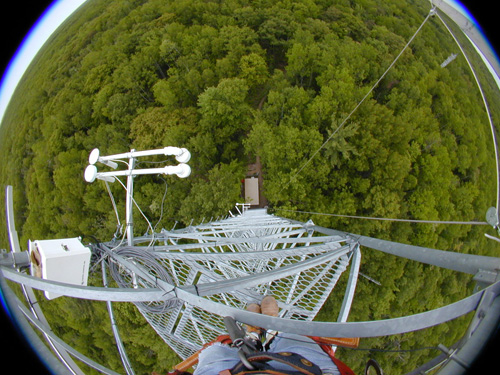 Above the forest canopy: looking down at the trees from a Michigan eddy-covariance tower.: Photograph by Chris Vogel
Above the forest canopy: looking down at the trees from a Michigan eddy-covariance tower.: Photograph by Chris Vogel
Using data collected in forests in the northeastern United States and elsewhere around the world, Keenan and Richardson found increases in efficiency larger than those predicted by state-of-the-art computer models.
The research was done in collaboration with scientists from the USDA Forest Service, Ohio State University, Indiana University and the Karlsruhe Institute of Technology in Germany.
"This could be considered a beneficial effect of increased atmospheric carbon dioxide," said Keenan, the first author of the Nature paper.
"What's surprising is we didn't expect the effect to be this big. A large proportion of the ecosystems in the world are limited by water--they don't have enough water during the year to reach their maximum potential growth.
"If they become more efficient at using water, they should be able to take more carbon out of the atmosphere due to higher growth rates."
While increased atmospheric carbon dioxide may benefit forests in the short-term, Richardson emphasized that the overall climate picture would remain grim if levels continue to rise.
"We're still very concerned about what rising levels of atmospheric carbon dioxide mean for the planet," Richardson said.
"There is little doubt that as carbon dioxide continues to rise--and last month we just passed a critical milestone, 400 parts per million for the first time in human history--rising global temperatures and changes in rainfall patterns will, in coming decades, have very negative consequences for plant growth in many ecosystems around the world."
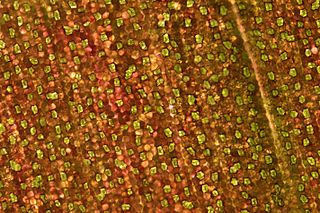 The underside of a leaf of Tradescantia zebrina. The majority of the surface is made up of epidermal cells with the occasional: stoma - a pore in the leaf which can open and close to control gas exchange, primarily to minimize loss of water vapor while still taking up carbon dioxide. In this species the stomata cells are green (due to chlorophyll) while the epidermal cells are red in color due to additional pigmentation. Text and Image courtesy of Zephyris from WikipediaHow do increasing carbon dioxide levels lead to more efficient water use?
The underside of a leaf of Tradescantia zebrina. The majority of the surface is made up of epidermal cells with the occasional: stoma - a pore in the leaf which can open and close to control gas exchange, primarily to minimize loss of water vapor while still taking up carbon dioxide. In this species the stomata cells are green (due to chlorophyll) while the epidermal cells are red in color due to additional pigmentation. Text and Image courtesy of Zephyris from WikipediaHow do increasing carbon dioxide levels lead to more efficient water use?
The answer, Keenan said, is in the way photosynthesis works.
To take in the carbon dioxide they need, plants open tiny pores, called stomata, on their leaves. As carbon dioxide enters, however, water vapor is able to escape.
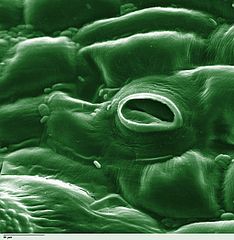 Colorized scanning electron microscope image of Lycopersicon esculentum (Tomato) lower leaf surface,: showing stomate and also some fungi attached to leaf surface. Text Louisa Howard, Dartmouth University Image courtesy of WikipediaHigher levels of carbon dioxide mean the stomata don't need to open as wide, or for as long, so the plants lose less water and grow faster.
Colorized scanning electron microscope image of Lycopersicon esculentum (Tomato) lower leaf surface,: showing stomate and also some fungi attached to leaf surface. Text Louisa Howard, Dartmouth University Image courtesy of WikipediaHigher levels of carbon dioxide mean the stomata don't need to open as wide, or for as long, so the plants lose less water and grow faster.
To take advantage of that fact, commercial growers have for years pumped carbon dioxide into greenhouses to promote plant growth.
To test whether such a "carbon dioxide fertilization effect" was taking place in forests, Keenan, Richardson and others turned to long-term data measured using a technique called eddy covariance.
This method, which relies on sophisticated instruments mounted on tall towers extending above the forest canopy, allows researchers to determine how much carbon dioxide and water are going into and out of the ecosystem.
With more than 20 years of data, the towers at the NSF Harvard Forest LTER site--which have the longest continuous record in the world--are an important resource for studying how forests have responded to changes in atmospheric carbon dioxide levels, scientists say.
"A goal of the NSF LTER program is understanding forest ecosystems and the basis for predicting fluxes of energy and materials in these ecosystems," said Matt Kane, program director in NSF's Division of Environmental Biology," as well as distributions of forest biota as a result of global climate change."
"Findings from this study are important to our understanding of forest ecosystems--and how they can be managed more effectively now and in the future."
Though more than 300 towers like Harvard Forest's have sprung up around the globe, many of the earliest--and hence with the longest data records--are in the northeastern United States.
When the researchers began to look at those records, they found that forests were storing more carbon and becoming more efficient in how they used water.
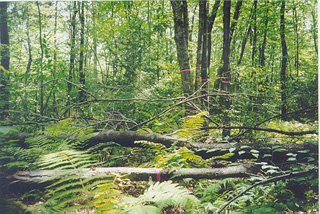 On the ground: looking into Harvard Forest's trees from a less lofty perch.: Photograph courtesy of NSF Harvard Forest LTER SiteThe phenomenon, however, wasn't limited to a single region. When the scientists examined long-term data sets from all over the world, the same trend was evident.
On the ground: looking into Harvard Forest's trees from a less lofty perch.: Photograph courtesy of NSF Harvard Forest LTER SiteThe phenomenon, however, wasn't limited to a single region. When the scientists examined long-term data sets from all over the world, the same trend was evident.
"We went through every possible hypothesis of what could be going on, and ultimately what we were left with is that the only phenomenon that could cause this type of shift in water-use efficiency is rising atmospheric carbon dioxide," Keenan said.
Going forward, Keenan, who is now at Macquarie University in Sydney, Australia, is working to get access to data collected from yet more sites, including several that monitor tropical and arctic systems.
"This larger dataset will help us better understand the extent of the response we observed," he said.
"That in turn will help us build better models, and improve predictions of the future of the Earth's climate.
"Right now, all the models we have underrepresent this effect by as much as an order of magnitude, so the question is: What are the models not getting? What do they need to incorporate to capture this effect, and how will that affect their projections for climate change?"
The research was also by a grant from supported by the National Oceanic and Atmospheric Administration’s Atmospheric Chemistry, Carbon Cycle, and Climate Program (NOAA). Field measurements at the sites, which are part of the AmeriFlux network, have also been funded by the Department of Energy’s Biological and Environmental Research Program and the U.S. Forest Service’s Northern Research Station.
This news is from the National Science Foundation (NSF),10 July 2013
Posted on the Horizon International Solutions Site on July 18, 2013
Related Websites
NSF Long-Term Ecological Research Network:http://www.lternet.edu
NSF Harvard Forest LTER Site:http://harvardforest.fas.harvard.edu/research/LTER
NSF Discovery Article: The Colors of Fall: Are Autumn Reds and Golds Passing Us By?:http://www.nsf.gov/discoveries/disc_summ.jsp?cntn_id=125511
NSF Publication: Discoveries in Long-Term Ecological Research:http://www.nsf.gov/pubs/2013/nsf13083/nsf13083.pdf?WT.mc_id=USNSF_25&WT.mc_ev=click
Search
Latest articles
Agriculture
- World Water Week: Healthy ecosystems essential to human health: from coronavirus to malnutrition Online session Wednesday 24 August 17:00-18:20
- World Water Week: Healthy ecosystems essential to human health: from coronavirus to malnutrition Online session Wednesday 24 August 17:00-18:20
Air Pollution
- "Water and Sanitation-Related Diseases and the Changing Environment: Challenges, Interventions, and Preventive Measures" Volume 2 Is Now Available
- Global Innovation Exchange Co-Created by Horizon International, USAID, Bill and Melinda Gates Foundation and Others
Biodiversity
- It is time for international mobilization against climate change
- World Water Week: Healthy ecosystems essential to human health: from coronavirus to malnutrition Online session Wednesday 24 August 17:00-18:20
Desertification
- World Water Week: Healthy ecosystems essential to human health: from coronavirus to malnutrition Online session Wednesday 24 August 17:00-18:20
- UN Food Systems Summit Receives Over 1,200 Ideas to Help Meet Sustainable Development Goals
Endangered Species
- Mangrove Action Project Collaborates to Restore and Preserve Mangrove Ecosystems
- Coral Research in Palau offers a “Glimmer of Hope”
Energy
- Global Innovation Exchange Co-Created by Horizon International, USAID, Bill and Melinda Gates Foundation and Others
- Wildlife Preservation in Southeast Nova Scotia
Exhibits
- Global Innovation Exchange Co-Created by Horizon International, USAID, Bill and Melinda Gates Foundation and Others
- Coral Reefs
Forests
- NASA Satellites Reveal Major Shifts in Global Freshwater Updated June 2020
- Global Innovation Exchange Co-Created by Horizon International, USAID, Bill and Melinda Gates Foundation and Others
Global Climate Change
- It is time for international mobilization against climate change
- It is time for international mobilization against climate change
Global Health
- World Water Week: Healthy ecosystems essential to human health: from coronavirus to malnutrition Online session Wednesday 24 August 17:00-18:20
- More than 400 schoolgirls, family and teachers rescued from Afghanistan by small coalition
Industry
- "Water and Sanitation-Related Diseases and the Changing Environment: Challenges, Interventions, and Preventive Measures" Volume 2 Is Now Available
- Global Innovation Exchange Co-Created by Horizon International, USAID, Bill and Melinda Gates Foundation and Others
Natural Disaster Relief
- STOP ATTACKS ON HEALTH CARE IN UKRAINE
- Global Innovation Exchange Co-Created by Horizon International, USAID, Bill and Melinda Gates Foundation and Others
News and Special Reports
- World Water Week: Healthy ecosystems essential to human health: from coronavirus to malnutrition Online session Wednesday 24 August 17:00-18:20
- STOP ATTACKS ON HEALTH CARE IN UKRAINE
Oceans, Coral Reefs
- World Water Week: Healthy ecosystems essential to human health: from coronavirus to malnutrition Online session Wednesday 24 August 17:00-18:20
- Mangrove Action Project Collaborates to Restore and Preserve Mangrove Ecosystems
Pollution
- Zakaria Ouedraogo of Burkina Faso Produces Film “Nzoue Fiyen: Water Not Drinkable”
- "Water and Sanitation-Related Diseases and the Changing Environment: Challenges, Interventions, and Preventive Measures" Volume 2 Is Now Available
Population
- "Water and Sanitation-Related Diseases and the Changing Environment: Challenges, Interventions, and Preventive Measures" Volume 2 Is Now Available
- "Water and Sanitation-Related Diseases and the Changing Environment: Challenges, Interventions, and Preventive Measures" Volume 2 Is Now Available
Public Health
- Honouring the visionary behind India’s sanitation revolution
- Honouring the visionary behind India’s sanitation revolution
Rivers
- World Water Week: Healthy ecosystems essential to human health: from coronavirus to malnutrition Online session Wednesday 24 August 17:00-18:20
- Mangrove Action Project Collaborates to Restore and Preserve Mangrove Ecosystems
Sanitation
- Honouring the visionary behind India’s sanitation revolution
- Honouring the visionary behind India’s sanitation revolution
Toxic Chemicals
- "Water and Sanitation-Related Diseases and the Changing Environment: Challenges, Interventions, and Preventive Measures" Volume 2 Is Now Available
- Actions to Prevent Polluted Drinking Water in the United States
Transportation
- "Water and Sanitation-Related Diseases and the Changing Environment: Challenges, Interventions, and Preventive Measures" Volume 2 Is Now Available
- Urbanization Provides Opportunities for Transition to a Green Economy, Says New Report
Waste Management
- Honouring the visionary behind India’s sanitation revolution
- Honouring the visionary behind India’s sanitation revolution
Water
- Honouring the visionary behind India’s sanitation revolution
- Honouring the visionary behind India’s sanitation revolution
Water and Sanitation
- Honouring the visionary behind India’s sanitation revolution
- Honouring the visionary behind India’s sanitation revolution

